Metal
The Gatchina Palace contained an extensive and diverse collection of bronze pieces, primarily lighting fixtures and clocks which was a reflection of its peculiar evolution.
After the palace was turned into a museum, the lighting fixtures of the Main Building acquired their original appearance, characteristic of the eighteenth century. A large number of bronze pieces from the Gatchina Palace were sold to buyers abroad in the 1930s. Among those irrevocably lost were some of the most unique objects such as the chandelier from the Crimson Drawing Room, which Paul I’s wife, the Empress Maria Feodorovna, assisted in its production. Some metal objects from the museum’s holdings were evacuated in part during World War II and those that were left behind were either plundered by the Nazis or lost in the fire of 1944.
Hide full description
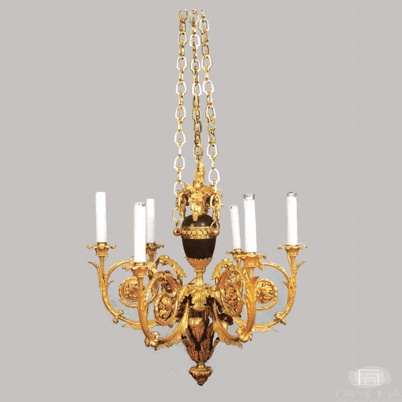 Five Light Chandelier
Five Light Chandelier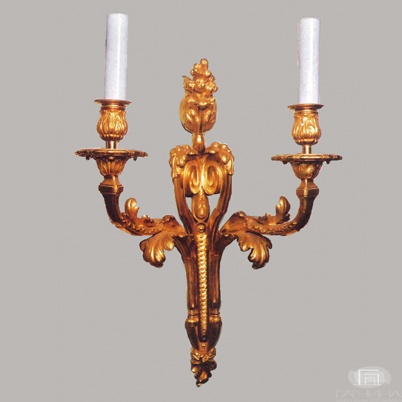 Two Branch Wall Lights
Two Branch Wall Lights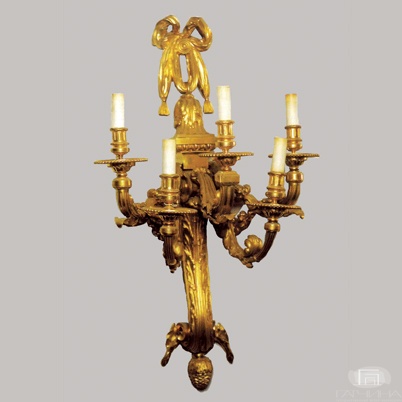 Five-Branch Wall Lights
Five-Branch Wall Lights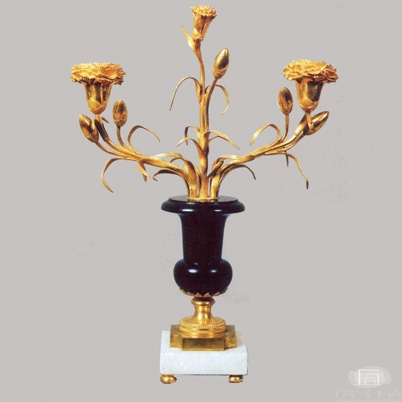 Two Light Candelabrum
Two Light Candelabrum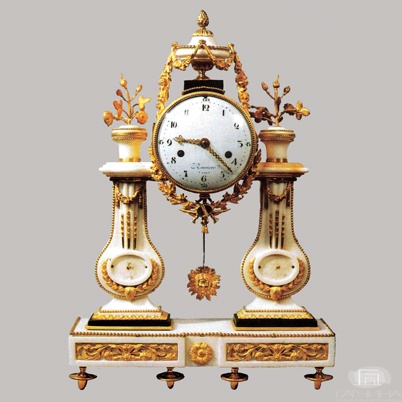 Mantel Clock
Mantel Clock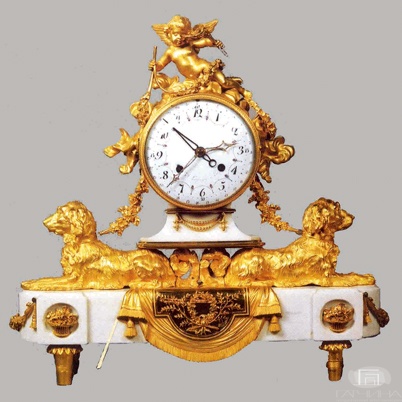 Mantel Clock with figures of dogs
Mantel Clock with figures of dogs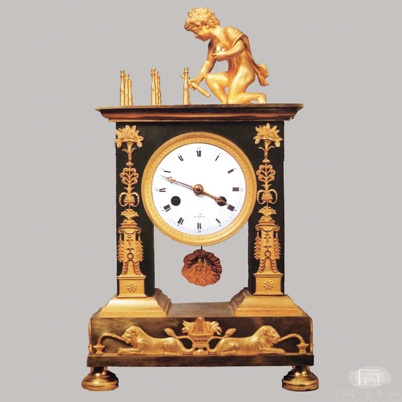 Mantel Clock with a Figure of a Boy Playing Skittles
Mantel Clock with a Figure of a Boy Playing Skittles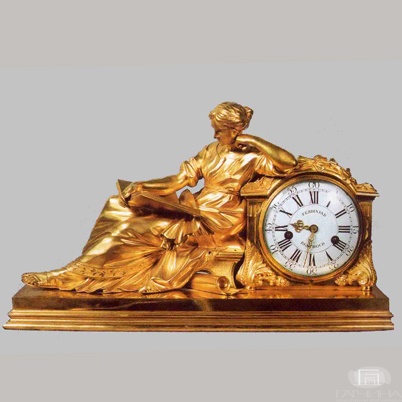 Mantel Clock “Reader”
Mantel Clock “Reader”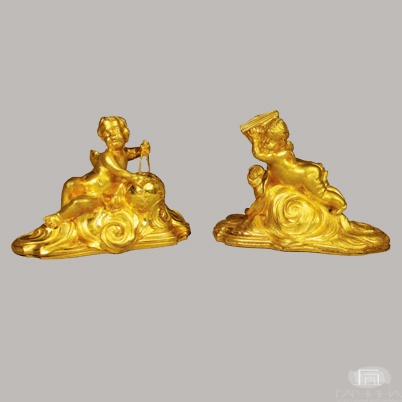 A Pair of Paperweights
A Pair of Paperweights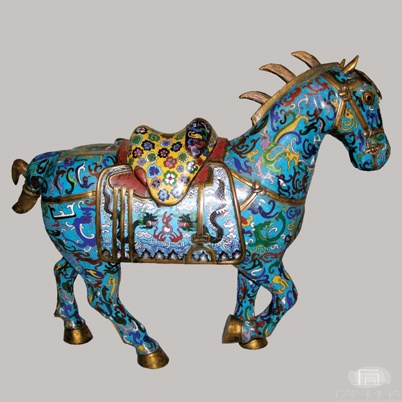 Incense burners in the shape of horses
Incense burners in the shape of horses
Five Light Chandelier.
French, ca. 1780. Gilt and patinated bronze.
It is quite likely that this chandelier was originally intended to decorate the interiors of the Mikhailovsky Castle that was then still being constructed, but it eventually ended up at the Gatchina Palace. Until World War II, it hung here in the Upper Throne Room of Paul I (the planning and interiors of this room are not restored yet). Scholars believe that it was made by Pierre Gouthiere, the foremost French bronze caster of the 18th century. A very similar chandelier hangs in the Gilded Study of Marie-Antoinette at Versailles.
French, ca. 1780. Gilt and patinated bronze.
It is quite likely that this chandelier was originally intended to decorate the interiors of the Mikhailovsky Castle that was then still being constructed, but it eventually ended up at the Gatchina Palace. Until World War II, it hung here in the Upper Throne Room of Paul I (the planning and interiors of this room are not restored yet). Scholars believe that it was made by Pierre Gouthiere, the foremost French bronze caster of the 18th century. A very similar chandelier hangs in the Gilded Study of Marie-Antoinette at Versailles.
Two Branch Wall Lights.
French, ca. 1770, gilt bronze.
Before WWII a pair of wall lights like these ones were in Upper Throne Room of Paul I (its planning and interiors are not restored yet).
French, ca. 1770, gilt bronze.
Before WWII a pair of wall lights like these ones were in Upper Throne Room of Paul I (its planning and interiors are not restored yet).
Five-Branch Wall Lights.
Gilt bronze, French, ca. 1770.
Sixteen wall lights such as this one illuminate the White Hall. They appear to have had three candle holders originally, but after regilding at the Chopin Factory in the mid-19th century, two more branches were added.
Gilt bronze, French, ca. 1770.
Sixteen wall lights such as this one illuminate the White Hall. They appear to have had three candle holders originally, but after regilding at the Chopin Factory in the mid-19th century, two more branches were added.
Two Light Candelabrum.
French, ca. 1770-80. Gilt bronze, white and black marble.
The two candelabra are now on the mantelpiece in the Marble Dining Room, as it was before World War II.
French, ca. 1770-80. Gilt bronze, white and black marble.
The two candelabra are now on the mantelpiece in the Marble Dining Room, as it was before World War II.
Mantel Clock.
French, Paris, clockmaker Jean-Louis Rouviere, ca. 1780. Gilt bronze, white and black marble.
The artwork is now on the mantelpiece in the Marble Dining Room, as it was before World War II.
French, Paris, clockmaker Jean-Louis Rouviere, ca. 1780. Gilt bronze, white and black marble.
The artwork is now on the mantelpiece in the Marble Dining Room, as it was before World War II.
Mantel Clock with figures of dogs.
French case, Paris, Belgian made movement, Liege, clockmaker and trader Louis-Jean Laguesse, ca. 1780. Gilt bronze, white marble.
It probably entered the palace collection in the late 18th century. Currently on view on the mantelpiece in the Upper Throne Room of Paul I.
French case, Paris, Belgian made movement, Liege, clockmaker and trader Louis-Jean Laguesse, ca. 1780. Gilt bronze, white marble.
It probably entered the palace collection in the late 18th century. Currently on view on the mantelpiece in the Upper Throne Room of Paul I.
Mantel Clock with a Figure of a Boy Playing Skittles.
French, Paris, after ca. 1825-1830. Gilt and patinated bronze.
First recorded in 1855, along with other clocks housed at the Gatchina Palace. Currently on view in the Bedroom of Grand Duchess Ksenia Alexandrovna, in the Arsenal Wing.
French, Paris, after ca. 1825-1830. Gilt and patinated bronze.
First recorded in 1855, along with other clocks housed at the Gatchina Palace. Currently on view in the Bedroom of Grand Duchess Ksenia Alexandrovna, in the Arsenal Wing.
Mantel Clock “Reader”.
French, Paris, ca. 1760, after a model by Laurent Guillard, the movement by Ferdinand Berthoud. Gilt bronze.
The artwork is now displayed on the mantelpiece in the White Hall, as it was before WWII.
French, Paris, ca. 1760, after a model by Laurent Guillard, the movement by Ferdinand Berthoud. Gilt bronze.
The artwork is now displayed on the mantelpiece in the White Hall, as it was before WWII.
A Pair of Paperweights “Genius in History” and “Genius in Geography”.
French, gilt bronze, ca. 1760.
The artwork is now in the Tower Study of Paul I, as it was before WWII.
French, gilt bronze, ca. 1760.
The artwork is now in the Tower Study of Paul I, as it was before WWII.
Incense burners in the shape of horses.
China, late 19th-early 20th c. Copper, cloisonné enamel.
Hollow figures of horses, pierced on top with removable saddle-shaped covers. The figures are decorated all over with stylized dragons adorned with “glowing” pearls, phoenixes, flowers and clouds. The artwork entered the Gatchina Museum collection in 2007 from the Oranienbaum Museum.
China, late 19th-early 20th c. Copper, cloisonné enamel.
Hollow figures of horses, pierced on top with removable saddle-shaped covers. The figures are decorated all over with stylized dragons adorned with “glowing” pearls, phoenixes, flowers and clouds. The artwork entered the Gatchina Museum collection in 2007 from the Oranienbaum Museum.
